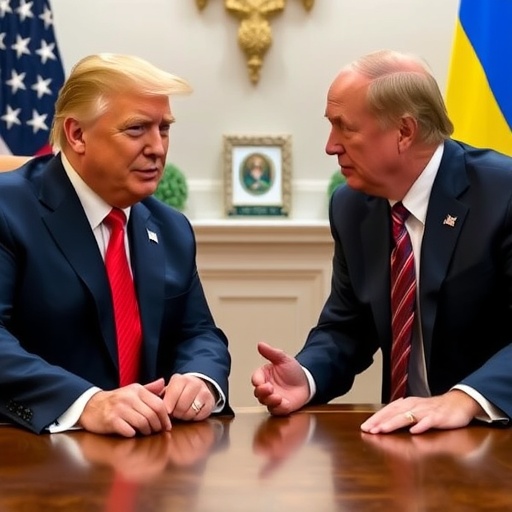Trump‘s Call for Ukraine to Surrender Donbas to Russia Sparks Fury as US-Russia Summit Looms in Budapest
In a stunning pivot that has sent shockwaves through international diplomacy, President Donald Trump declared that Ukraine should relinquish control of the Donbas region to Russia as a prerequisite for peace, just as preparations accelerate for a high-stakes US-Russia summit in Budapest. This provocative stance, voiced during a fiery rally in Florida, challenges decades of US foreign policy and raises fears of a major shift in the ongoing conflict that has ravaged Eastern Europe since 2014.
- Trump’s Rally Rhetoric: A Direct Challenge to Ukrainian Resolve
- Donbas Dilemma: Why This Region Fuels Endless Ukraine-Russia Tensions
- Budapest Summit Buzz: US-Russia Preparations Under Scrutiny
- Global Backlash: Allies and Adversaries React to Trump’s Peace Proposal
- Future Fault Lines: What Lies Ahead for Ukraine, Russia, and US Diplomacy
Trump‘s remarks, delivered to a cheering crowd of supporters, underscore his administration’s aggressive push for deal-making on the global stage. “Ukraine needs to give up Donbas—it’s been a mess for years. Let Russia have it, and we can all move on to bigger things,” Trump stated emphatically, framing the concession as a pragmatic solution to end the bloodshed. The comments come amid reports of intensifying peace talks between Washington and Moscow, with the Budapest summit slated for next month potentially reshaping alliances in the region.
The Donbas, a resource-rich industrial heartland straddling Ukraine’s border with Russia, has been the epicenter of the conflict, claiming over 14,000 lives since pro-Russian separatists seized parts of it in 2014. Trump’s intervention injects fresh controversy into US-Russia relations, already strained by sanctions, cyber accusations, and NATO expansions. Critics argue this betrays Ukraine’s sovereignty, while proponents see it as a bold step toward de-escalation.
Trump’s Rally Rhetoric: A Direct Challenge to Ukrainian Resolve
President Trump’s unfiltered address at the Miami rally on Saturday evening marked a departure from the more measured tones of previous US leaders on the Ukraine crisis. Flanked by American flags and a sea of red hats, Trump painted a vivid picture of the war’s toll, citing economic costs to the US—estimated at $50 billion in aid since 2022 alone—and questioning why America should foot the bill for a “European problem.”
“I’ve got the best deals, folks. Russia wants peace, Ukraine wants peace, but they’re stuck on this Donbas nonsense,” Trump proclaimed, drawing applause from the audience. He referenced his past summits with Vladimir Putin, claiming they forged a personal rapport that could broker a swift resolution. This isn’t the first time Trump has waded into the fray; during his 2024 campaign, he repeatedly promised to end the war “in 24 hours,” though details were scarce.
Behind the rhetoric lies a strategic calculus. Sources close to the White House indicate that Trump’s team views the Donbas handover as a bargaining chip to secure Russian concessions elsewhere, such as reduced influence in the Black Sea or limits on military exercises near NATO borders. Yet, the proposal risks alienating key allies. European diplomats, speaking on condition of anonymity, expressed dismay, noting that it echoes Moscow’s long-standing demands under the Minsk agreements, which have stalled since 2015.
To flesh out the context, the Donbas conflict originated from Russia’s annexation of Crimea in 2014, followed by separatist uprisings backed by Moscow. The region, home to 4.5 million people before the war, boasts vast coal reserves and steel industries that once fueled the Soviet economy. Today, it’s a scarred landscape of trenches and minefields, with the UN reporting over 3 million displaced since the full-scale invasion in 2022.
Donbas Dilemma: Why This Region Fuels Endless Ukraine-Russia Tensions
The Donbas isn’t just territory—it’s a symbol of identity and power in the Ukraine-Russia saga. Comprising the Luhansk and Donetsk oblasts, the area has deep ethnic Russian ties, with Russian speakers forming a majority. Separatist forces, supported by Russian arms and fighters, declared independence in 2014, leading to a frozen conflict that simmered until the 2022 escalation.
Statistics paint a grim picture: According to the International Crisis Group, artillery fire in Donbas has displaced 1.5 million internally, while cross-border skirmishes have killed hundreds annually. Economically, the region’s output has plummeted 80% since 2014, turning former industrial giants like the Avdiivka Coke Plant into rubble-strewn relics. Trump’s suggestion to cede it ignores these human costs, focusing instead on geopolitical realignment.
Historical precedents abound. The Minsk II accords of 2015 aimed to grant Donbas autonomy within Ukraine, but implementation faltered over control of borders and elections. Putin has insisted on recognition of the self-proclaimed Donetsk and Luhansk People’s Republics, a red line for Kyiv. Ukrainian President Volodymyr Zelenskyy, in a recent interview with BBC, reaffirmed that “Donbas is Ukrainian soil, and no amount of pressure will change that.”
Experts weigh in on the feasibility. Dr. Fiona Hill, former National Security Council official, told CNN that Trump’s idea “plays into Putin’s hands, weakening NATO’s deterrence.” Conversely, realpolitik advocates like John Mearsheimer argue in Foreign Affairs that acknowledging Russian spheres of influence could stabilize Eurasia, preventing broader escalation.
Public opinion in Ukraine remains staunchly opposed. A 2023 Kyiv International Institute of Sociology poll showed 85% of Ukrainians reject territorial concessions, viewing them as capitulation. In Russia, state media hailed Trump’s words as “realistic,” with Kremlin spokesman Dmitry Peskov noting, “We welcome any dialogue that respects historical realities.”
Budapest Summit Buzz: US-Russia Preparations Under Scrutiny
As Trump‘s comments reverberate, eyes turn to Budapest, where the upcoming US-Russia summit promises to be a diplomatic tinderbox. Hosted by Hungary’s Viktor Orbán—a Trump ally known for his pro-Moscow leanings—the event is tentatively scheduled for early March. Agenda items include arms control, energy security, and, prominently, the Ukraine impasse.
Preparatory meetings have already begun in Vienna, with US envoy Keith Kellogg shuttling between delegations. Reports from Reuters suggest Russia seeks lifting of Western sanctions in exchange for a ceasefire, while the US pushes for verifiable troop withdrawals from Donbas. The choice of Budapest is telling: Hungary has vetoed EU aid to Ukraine multiple times, positioning itself as a neutral broker.
Logistics are ramping up. Hungarian officials announced heightened security, with 2,000 police deployed and airspace restrictions in place. Protests are anticipated; Ukrainian diaspora groups in Europe plan demonstrations, chanting “No Surrender!” Meanwhile, tech firms like Zoom and secure comms providers are gearing up for virtual side sessions, given travel bans on Russian officials.
The summit’s stakes are high. Success could thaw US-Russia ties, frozen since the 2016 election interference allegations. Failure might embolden hardliners on both sides, risking renewed offensives in Donbas. Analysts from the Atlantic Council predict a 40% chance of breakthrough on humanitarian corridors, but only 20% for territorial deals.
Orbán’s role adds intrigue. In a January op-ed for Politico, he urged “pragmatic peace,” echoing Trump’s vision. Yet, NATO Secretary-General Jens Stoltenberg warned in Brussels that any deal undermining Article 5 commitments would be “unacceptable,” highlighting fractures within the alliance.
Global Backlash: Allies and Adversaries React to Trump’s Peace Proposal
Trump’s Donbas gambit has elicited a torrent of responses, from outrage in Kyiv to cautious optimism in Moscow. Ukrainian Foreign Minister Dmytro Kuleba lambasted the idea on Twitter, stating, “Surrendering territory won’t bring peace—it invites aggression. America must stand with Ukraine, not against it.” Protests erupted in Kyiv’s Maidan Square, where thousands waved blue-and-yellow flags, decrying US betrayal.
In Washington, bipartisan criticism mounted. Senate Majority Leader Chuck Schumer called it “reckless diplomacy that endangers our allies,” while Republican hawk Lindsey Graham tweeted, “Mr. President, strength, not appeasement, deters Putin.” Even Trump’s base is divided; a Fox News poll showed 55% of Republicans support negotiations but only 30% back concessions.
European leaders voiced alarm. UK Prime Minister Rishi Sunak, in a House of Commons address, affirmed London’s $3 billion aid commitment to Ukraine, vowing no tolerance for territorial carve-ups. France’s Emmanuel Macron proposed an emergency EU summit, emphasizing “Ukraine’s right to self-determination.”
Russia’s reaction was predictably warmer. Putin, in a state TV appearance, praised Trump’s “courageous stance,” hinting at flexibility on other issues like grain exports through the Black Sea. This aligns with Moscow’s narrative of the war as a civil conflict in Donbas, not an invasion.
Further afield, China watched closely. Beijing, a Russian economic lifeline, urged “restraint” via state media, while quietly boosting oil purchases from Moscow. In the Middle East, Saudi Arabia offered to mediate, leveraging its neutral stance in global conflicts.
Civil society isn’t silent. Human rights groups like Amnesty International highlighted Donbas civilians’ plight, with reports of 500 civilian deaths in 2023 alone from indiscriminate shelling. Refugee advocates fear mass exodus if peace talks falter.
Future Fault Lines: What Lies Ahead for Ukraine, Russia, and US Diplomacy
Looking forward, Trump’s proposal could redefine the contours of peace talks, but at what cost? If the Budapest summit yields a Donbas framework, it might halt fighting but ignite domestic unrest in Ukraine, potentially toppling Zelenskyy’s government. Economists forecast a 5% GDP boost for Ukraine with stability, per World Bank models, yet territorial loss could slash that by half through lost revenues.
For Russia, concessions might ease sanctions pressure, allowing $100 billion in frozen assets’ release. Putin could tout it as victory, bolstering his 2024 re-election bid. Yet, hardline nationalists in Moscow decry any compromise as weakness.
US implications are profound. Trump’s approach signals a transactional foreign policy, prioritizing deals over values—a shift from Biden-era multilateralism. Congress may push back with new aid bills; a $60 billion package for Ukraine is pending, tied to border security debates.
NATO’s future hangs in balance. Expansion talks with Sweden and Finland could accelerate, countering perceived US wavering. Intelligence reports warn of Russian hybrid threats, like cyberattacks on Ukrainian infrastructure during talks.
Ultimately, the path to peace remains fraught. As envoys converge on Budapest, the world watches whether Trump’s bold stroke fosters resolution or fractures the post-Cold War order. Stakeholders urge inclusive dialogue, ensuring Donbas voices—long silenced by war—are heard in the halls of power.








